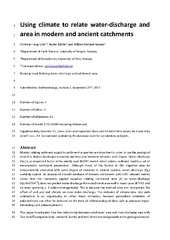Using climate to relate water-discharge and area in modern and ancient catchments
Peer reviewed, Journal article
Accepted version
Permanent lenke
https://hdl.handle.net/1956/19790Utgivelsesdato
2018-06Metadata
Vis full innførselSamlinger
- Department of Earth Science [1050]
Originalversjon
https://doi.org/10.1111/sed.12426Sammendrag
Models relating sediment supply to catchment properties are important in order to use the geological record to deduce landscape evolution and interplay between tectonics and climate. Water-discharge (Qw) is an important factor in the widely used BQART-model of Syvitski and Milliman (2007), which relates sediment load to a set of measureable catchment parameters. Although many of the factors in this equation may be independently estimated with some degree of certainty in ancient systems, water-discharge (Qw) certainly cannot. An analysis of a world database of modern catchments (Milliman and Farnsworth, 2011) shows that the commonly applied equation relating catchment area (A) to water-discharge (Qw=0.075A0.8), does not predict water-discharge from catchment area well in many cases (R2=0.5 and an error spanning c. 3 orders-of-magnitude). This is because the method does not incorporate the effect of arid and wet climate on river water-discharge. The inclusion of climate-data into such estimations is an opportunity to refine these estimates, because generalized estimates of palaeoclimate can often be deduced on the basis of sedimentological data such as palaeosol types, mineralogy and palaeohydraulics. This paper investigates how the relationship between catchment area and river discharge vary with four runoff categories (arid, semiarid, humid, and wet) which are recognizable in the geological record, and modifies the coefficient and exponent of the abovementioned equation according to these classes. Our modified model yields improved results in relating discharge to catchment area (R2=0.95 and error spanning 1 order-of-magnitude) when core-, outcrop- or regional palaeoclimate reconstruction data are available in non-arid systems. Arid systems have an inherently variable water-discharge, and catchment area is less important as a control due to downstream losses. The model here is sufficient for many geological applications and makes it possible to include variations in catchment humidity in mass-flux estimates in ancient settings.
